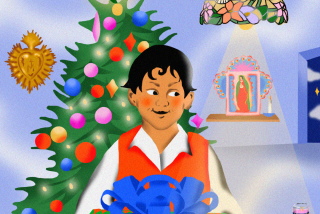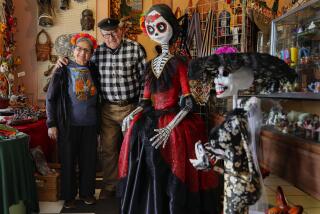Art Figures Are Puerto Rico Collector’s Items
- Share via
SAN JUAN, Puerto Rico — Collectors are snapping up antique and contemporary wooden religious statues from galleries in Old San Juan, as well as from artists scattered around the island.
Called “santos,” the figures are small statues beautifully carved out of cedar, laurel and other local woods and represent religious subjects such as the Nativity, Crucifixion, Virgin Mary, Three Wise Men and popular saints.
Statue styles are realistic to naive and roughly finished. They are found in galleries as well as in the studios of santeros (santos makers), some of which are open to the public.
Techniques for making the carved pieces have been passed down through history, according to cultural commentator Feliz Garmendia Santos, who is based in Ponce, Puerto Rico’s second largest city.
“Santeros hand down their art from generation to generation, with the kids usually beginning to carve at a very young age, maybe 6 or 7,” Garmendia said. “You can still see whole families of santeros in small towns in the mountains. In Ponce we have the family of Domingo Orta, one of the most important santeros in Puerto Rico.”
Puerto Rico’s santos tradition probably originated with the arrival of the Spanish, who introduced statues of patron saints to Latin America. But it was in Puerto Rico where the art really took hold.
The first santeros in Puerto Rico carved copies of the religious statues brought from Spain, so that other settlers going to remote parts of the island would have images with which to pray.
Until about 50 years ago santos were particularly important in rural areas where there were no churches and priests only passed through occasionally.
Usually, the santeros worked on commission, making saints to order. Such statues were unsigned, often repainted to cover faded or chipped colors and handed down from generation to generation.
Only a few of the old-time santeros have been identified.
Among them, those made by the families of Caban, Cajigas, Cartagena and Garcia are highly valued. So when a piece cannot be attributed to one artist it is classified by region or origin or characteristics. For example, some santos are known by the descriptive name cachetones, which in Spanish refers to puffed-cheeks.
Although Puerto Rico’s santos tradition is still flourishing, it has changed over the years. Not all of the artists sculpt out of religious conviction. Some work with the old techniques, handcrafting each statue from start to finish.
Others use power saws to cut out basic shapes before carving details by hand. Most contemporary santeros accept commissions to make special figures, but more often they sculpt their favorites from among the most popular saints. The statues are sold from their workshops or in galleries in Old San Juan or Ponce.
Standard inventory usually includes the Three Wise Men, the Virgin, St. Francis, St. Peter, St. John the Baptist, St. Anthony of Padua and St. Roch. Also popular is La Mano Poderosa (the All-Powerful Hand of Christ), representing the hand of a crucified Christ supporting figures of the child Christ, the Virgin Mary, St. Joseph, St. Anne and St. Joachim.
Most of the antique figures come to the market through dealers who scour the countryside searching for them. They are removed from alters in homes in remote mountain towns and their owners, convinced they are worth more in sentimental than real value, are persuaded to trade them for more showy, shinier plaster editions of the same saint, Garmendia said.
In Old San Juan galleries, increasingly rare antique statues bring dealers hundreds of dollars each.
Some Puerto Rican folk art scholars, including Teodoro Vidal, who owns one of the world’s biggest and best santos collections, believe that antique santos are part of Puerto Rico’s heritage and should be kept on the island. But as yet, no regulations prevent their removal.
Not all Puerto Rico’s contemporary santeros grew up in the santos tradition. Carlos Anzueta was born in Puerto Rico but raised in Chicago.
“I was always doing art as far back as I can remember, but I didn’t know anything about santos until I moved back to the island,” he said. “In Chicago my sixth grade teacher told me, ‘Carlos, you’re gonna be known for modern saints.’ But I was thinking more along the lines of (the type of saints depicted by) Leonardo or Michelangelo until I moved back to Puerto Rico and Botello, the gallery owner, suggested I carve santos. “
Anzueta’s figures, characterized by elongated bodies and faces with almost Asian features, are highly detailed. They are colored with pastel dyes that allow the wood grain to show through.
His favorite santos are the Three Wise Men and St. Francis, with whom he identifies. The figures range from 1/4-inch miniatures presented in their own special boxes to 12-inch figures. Prices begin at $45 for a simple four-inch figure, and eight-inch figures average about $150.
Anzueta also makes tiny 1/2-inch-tall nativity scenes that sell for about $250 and very special sets of 14-inch-tall Wise Men, with each figure carrying a box filled with a tiny angel choir, or a nativity and or Three Wise Men that sell for about $2,500.
To find santos, both old and new, contact any of the following studios:
Galeria Botello--208 Cristo St., Old San Juan, (809) 723-9987--is devoted primarily to the paintings and prints of Spanish-born contemporary artist Angel Botello (1913-1986). It contains a showcase full of antique santos selling from $200 to $1,300, that belonged to Botello, who restored them to their original colors, often by removing six or seven coats of paint.
Another excellent source for antique santos is Ole--105 Fortaleza St., Old San Juan, (809) 724-2445--an antique gallery belonging to Guillermo Cristian Jeffs, who is knowledgeable about vintage santos. The selection includes pieces made by master carvers Florencio and Quiterio Caban for $300 and up.
Contemporary santos are more affordable. Puerto Rican Arts and Crafts--204 Fortaleza St., Old San Juan, (809) 725-5596--has a variety of pieces by contemporary santeros, including the works of the highly-respected Domingo Orta family, including Domingo Orta Sr., his wife Santia Rivera de Orta and sons Domingo Jr., Wilfredo, Luis and Jose. Carved in a realistic style, the figures are delicate, with detailed features and beautiful hands.
Orta Sr. began making santos 36 years ago. He grew up around the art, but spent the early part of his career carving masks out of gourds.
Orta Sr.’s santos are 8 to 15 inches tall. His favorite santos figure is that of the Three Wise Men, especially if the bodies and the horses they’re riding are carved from a single piece of wood, rather than carved separately and glued together. He often carves the santos’ hands as part of the figure, while others carve hands separately and glue them into place.
Stylistically, statues made by other members of the Orta family are similar to those carved by Domingo Orta Sr., and all use an antiquing process to color their work. But there are differences, too. Santia prefers to carve miniatures of the Three Wise Men about two to four inches tall. Domingo Jr. frequently sculpts ordinary working men and women as well as saints.
Work of the Ortas family is also offered at a workshop in the basement of their home--Calle Lorencita Ferre No. I 59, El Tuque, Ponce, (809) 841-8717--amid a clutter of blocks of wood, half-finished statues, cutting tools and sandpaper. The small room is sweetly scented with cedar.
Visitors are welcome and the trip, a scenic 1 1/2-hour drive from Old San Juan, is worth the effort. In addition to the privilege of meeting the artists and soaking up the ambience of their workshop, you’ll usually find a much larger selection of santos. And prices, from about $55 for a Santia Three Wise Men to about $200 for a sculpture of the Three Wise Men done by Orta Sr., are about 30% to 50% less than gallery tags.
Anzueta’s santos are sold at Puerto Rican Arts and Crafts in Old San Juan, or at his studio in the town of Corozal, about a one-hour drive from Old San Juan. Call (809) 859-7159 for an appointment and directions.
Prices in this article reflect currency exchange rates at the time of writing.
More to Read
Sign up for The Wild
We’ll help you find the best places to hike, bike and run, as well as the perfect silent spots for meditation and yoga.
You may occasionally receive promotional content from the Los Angeles Times.






